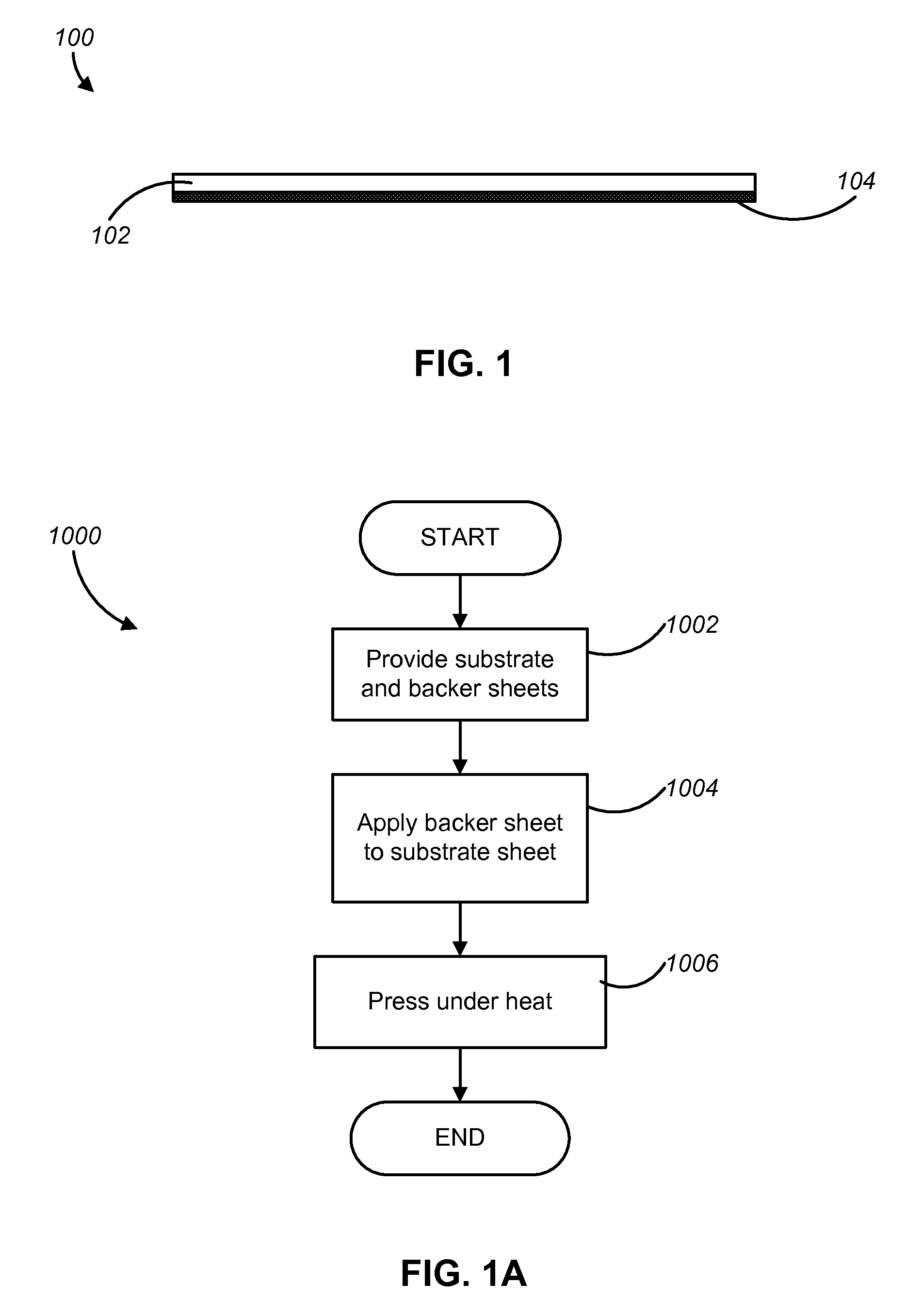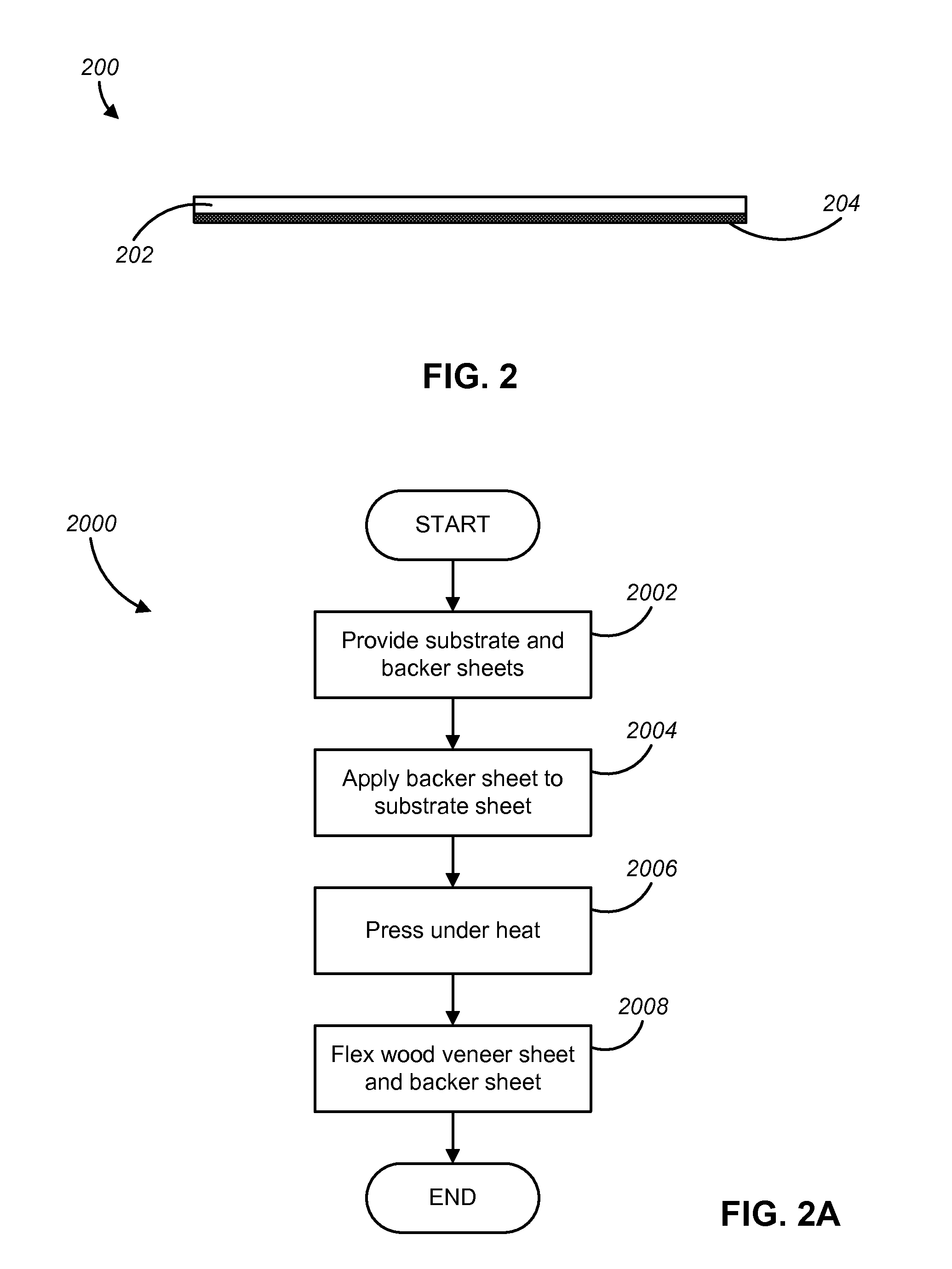Decomposable composite wood sheets
a composite wood and wood sheet technology, applied in the field of decomposable composite wood sheets, can solve the problems of additive leakage, increase the pliability of plastics, and increase the human and environmental cost, and achieve the effect of reducing harmful landfill waste, strength and flexibility
- Summary
- Abstract
- Description
- Claims
- Application Information
AI Technical Summary
Benefits of technology
Problems solved by technology
Method used
Image
Examples
embodiment 1
FIG. 1 shows a side view of a sheet (100), in accordance with one embodiment. The sheet (100) includes a main substrate (102) made of thin wood veneer, which is laminated with a transparent backer (104) made from long-fibrous cellulose on one side of the main substrate (102). The combination of wood veneer and cellulose backer improves the strength and flexibility of the sheet (100), making it comparable to conventional sheets made of PVC or similar materials. The thickness of the substrate (102) is approximately 0.10-1.50 mm and the thickness of the cellulose backer (104) is approximately 0.05-0.5 mm, thus resulting in a sheet (100) with a total thickness in the range of approximately 0.15-2.00 mm that can be used in a variety of applications where conventional plastics are used today.
Essentially any type of wood species that can be used to make veneer is suitable for use as the main substrate (102). Some examples of wood species that are particularly good include birch, pine, ash,...
embodiment 2
FIG. 2 shows a further embodiment of a sheet (200) that is essentially structurally identical to the sheet (100) shown in FIG. 1. However, the process (2000) for manufacturing the sheet (200) is slightly different, as will now be described with respect to FIG. 2A.
As can be seen in FIG. 2A, steps 2002 through 2006 are identical to steps 1002-1006, respectively, of FIG. 1A. The main difference between the sheet (200) and the sheet (100) described in the above embodiment is that a further step 2008 is added, in which the laminated substrate sheet (202) and backer sheet (204) are flexed in a flexer. Flexing is a technique that is used within many areas of the wood processing industry, and essentially means that the laminated sheet is pressed between two heavy rollers, similar to how fabric sheets, table cloths, etc. can be pressed between the two rollers of a mangle or wringer to flatten them. For the laminated substrate (202) and backer sheet (204), this causes the fibers in the substr...
embodiment 3
FIG. 3 shows a side view of a sheet (300), in accordance with one embodiment. Similar to what has been described above, the sheet (300) includes a main substrate (302) made of thin wood veneer. However, this embodiment has a transparent backer (304) made from long-fibrous cellulose laminated on either side of the main substrate (302). The combination of a wood veneer substrate (302) and cellulose backers (304) on either side still improves the strength and flexibility of the sheet (300). The dimensions and materials used for the substrate (302) and backer (304) are essentially the same as the dimensions and materials described above with respect to Embodiments 1 and 2.
FIG. 3A shows a process (3000) for manufacturing a sheet (300), in accordance with one embodiment. As can be seen in FIG. 3A, the process starts by providing one sheet of wood veneer (302) and two sheets of cellulose backer (304) (step 3002). Next, the two sheets of cellulose backer (304) are applied to the wood veneer...
PUM
| Property | Measurement | Unit |
|---|---|---|
| degree of transparency | aaaaa | aaaaa |
| size | aaaaa | aaaaa |
| width | aaaaa | aaaaa |
Abstract
Description
Claims
Application Information
 Login to View More
Login to View More - R&D
- Intellectual Property
- Life Sciences
- Materials
- Tech Scout
- Unparalleled Data Quality
- Higher Quality Content
- 60% Fewer Hallucinations
Browse by: Latest US Patents, China's latest patents, Technical Efficacy Thesaurus, Application Domain, Technology Topic, Popular Technical Reports.
© 2025 PatSnap. All rights reserved.Legal|Privacy policy|Modern Slavery Act Transparency Statement|Sitemap|About US| Contact US: help@patsnap.com



